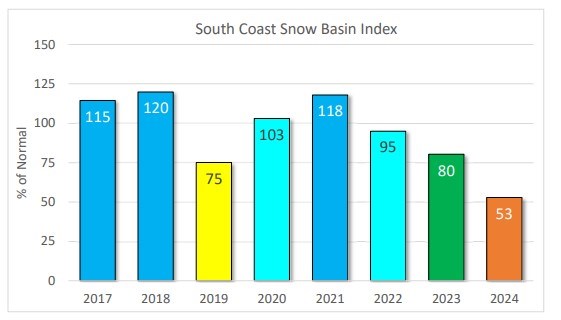The overall snowpack level in B.C. is at 63 per cent of normal, according to an April 10 statement from Nathan Cullen, Minister of Water, Land and Resource Stewardship. But snow volume assessments for the Chapman Creek watershed show 59 per cent of expected levels and that dips to 51 per cent in the lower elevations of the Edwards Lake area. Those values were reported based on measurements taken April 3 through the Ministry of Environment and Climate Change Strategy’s Snow Survey Program, which indicated the South Coast region had a snowpack at 53 per cent of its normal volume.
“In both cases, it is significantly lower, but also similar to the provincial picture of it being a record low snowpack,” manager of infrastructure services at the Sunshine Coast Regional District (SCRD) Remko Rosenboom said in an April 11 interview with Coast Reporter. The provincial statement said the April snow level measurements were the “lowest in 50 years."
SCRD staff were onsite at Chapman and Edwards Lakes during the first week of April and are planning another visit the week of April 15 for further snow survey work. Other SCRD water systems, including North and South Pender are either lake or groundwater-based, with supplies not influenced heavily by snow levels. “All the lakes are currently full and aquifers are currently at where we expect them to be,” Rosenboom said. He added that performance of those watersheds over the summer months depends on rain volumes received.
Stage 2 call for Chapman system may be early this year
“Snowpack is only one driver of what we foresee coming in future months. Chapman is a rain, not a snow-dependent system. If there is a lot of rain in the upcoming weeks and a lot of rain over the summer, we might be totally fine. Snowpack is only impacting when we go to Stage 2 [restrictions],” he stated.
An SCRD bylaw mandates that Stage 1 water restrictions for users on all its water systems come into force on May 1. Rosenboom said there is “no need” to do that any earlier.
The earliest date water restrictions moved to Stage 2 for the Chapman system was June 7 (in 2019) but Rosenboom said that change could happen in late May or earlier in June this year due to low snow levels in the catchment area.
On-site chemical storage at Granthams needed by Stage 2 call
“From a water supply perspective, with Church Road online, we are in a better situation compared to the last several years,” Rosenboom said of the region’s Chapman system.
But the SCRD needs to resolve a chemical storage issue to add Church Road water at full capacity to the Chapman system. “We cannot operate [the Grantham water treatment plant] safely without any storage of sodium hypochlorite on site. Some form of solution, interim or permanent, will have to be in place before we start operating that facility,” he stated.
Plans to put a Sea-Can storage unit at the facility, located at Fisher Road and Elphinstone Avenue, were paused after residents in the area expressed a range of concerns in emails to the SCRD board and at an engagement session hosted March 28. As that online event closed, Rosenboom who served as its moderator, committed to visit the site to look and discuss siting alternatives with those concerned. He confirmed that happened last week and said that SCRD staff are “currently reviewing more options."
When there is “news to share” about site chemical storage for the Church Road/Granthams site, Rosenboom said area residents will be contacted first, followed by release of those details to the media and general public.
Provincial actions to prepare for potential drought
In ihis statement, Cullen outlined actions the province was taking to “help communities, farmers and industry prepare for drought now so we can respond quickly, recover faster and be more ready for drier conditions." Rosenboom confirmed that a provincially sponsored workshop to help farmers prepare for drought and to connect them with financial support, including its Agriculture Water Infrastructure Program, was hosted for the Coast’s agriculture community earlier this month.
As for what the Minister called “regional tables in key drought-impacted areas," Rosenboom said he wasn’t aware of that type of initiative being established locally so far. “There’s a big difference between where we are at and where a lot of the province are at in terms of understanding how water systems work," he said. As the SCRD has been active in drought management since 2015, his view is that those regional tables will likely be focused on areas that have not had the level of drought being anticipated for in 2024 in the past.
When it comes to how to manage drought conditions, “We are well ahead of a lot of the other areas in the province," said Rosenboom. That, in his view, is based on both the SCRD’s and residents' understanding of the limitations of local water supplies and how to conserve that resource.



